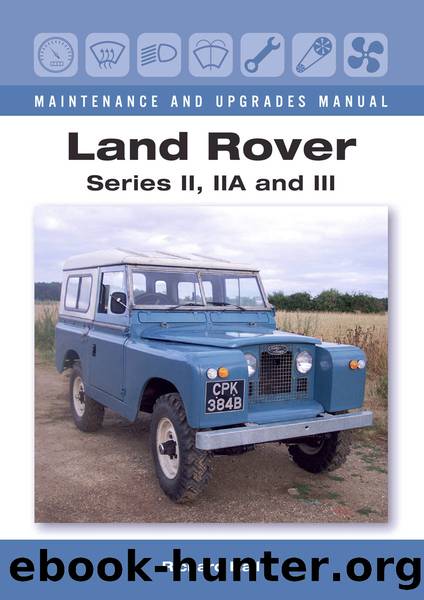Land Rover Series II, IIA and III Maintenance and Upgrades Manual by Richard Hall

Author:Richard Hall
Language: eng
Format: epub
Publisher: The Crowood Press
Four-wheel drive selector shafts are behind this pressed steel cover.
⦠Reverse gear selection: the reverse gear detent consists of a hinged flap and two springs attached to the reverse selector fork. When a spring breaks, the flap sticks up, allowing reverse to be engaged as easily as first. The springs can be replaced without too much trouble, but the floors and transmission tunnel have to come out.
⦠Sticking transfer lever: on vehicles where four-wheel drive and low ratio are infrequently used, the shafts inside the transfer box can stick. The usual symptom is that it becomes impossible to engage high ratio without also pushing down the yellow knob for four-wheel drive. The front ends of the shafts are concealed under a pressed steel cover on the front extension housing:if this is removed, lubricating the shafts and giving them a tap with a hammer, then working them back and forth, will usually restore normal operation.
⦠Jammed gear lever: the ball at the bottom end has a groove in it for an âOâ ring to stop it rattling. Sometimes a combination of missing âOâring, worn ball and worn forks allows the ball to slip between two of the forks, jamming the mechanism entirely. The floors and transmission tunnel will need to come out so the gear lever can be removed for attention. Gear levers can also break off at the bottom due to metal fatigue: it is not uncommon to find they have been welded back on.
⦠âCrunchingâ between gears: Series II and IIA gearboxes have no synchromesh on first or second gear, so you will need to master the double-declutching technique for crunch-free changes. Crunching on third and fourth gear is usually caused by failure of the flat metal springs in the third/fourth gear synchromesh hub:these are almost impossible to replace without stripping the gearbox, but it will happily plod on like this for quite a while, provided you doubledeclutch and change gear slowly. First/second gear synchromesh hubs on Series III gearboxes have a weak spot where the synchromesh rings locate: the corners of the hub break off, eventually leading to a very notchy and obstructive selection of first and/or second gear. The synchromesh rings also wear with age and can be âbeatenâ if changing gear too quickly.
Download
This site does not store any files on its server. We only index and link to content provided by other sites. Please contact the content providers to delete copyright contents if any and email us, we'll remove relevant links or contents immediately.
Machine Learning at Scale with H2O by Gregory Keys | David Whiting(4258)
Never by Ken Follett(3883)
Urban Outlaw by Magnus Walker(3365)
OPNsense Beginner to Professional by Julio Cesar Bueno de Camargo(3262)
Sapiens and Homo Deus by Yuval Noah Harari(3029)
Will by Will Smith(2872)
A Short History of Nearly Everything by Bryson Bill(2659)
Hooked: A Dark, Contemporary Romance (Never After Series) by Emily McIntire(2527)
Rationality by Steven Pinker(2327)
Borders by unknow(2280)
The Becoming by Nora Roberts(2150)
Holy Bible (NIV) by Zondervan(2101)
HBR's 10 Must Reads 2022 by Harvard Business Review(1820)
A Short History of War by Jeremy Black(1816)
The One Percenter Encyclopedia by Bill Hayes(1811)
Freedom by Sonny Barger(1783)
Go Tell the Bees That I Am Gone by Diana Gabaldon(1731)
Five Ways to Fall by K.A. Tucker(1724)
Girls Auto Clinic Glove Box Guide by Patrice Banks(1707)
